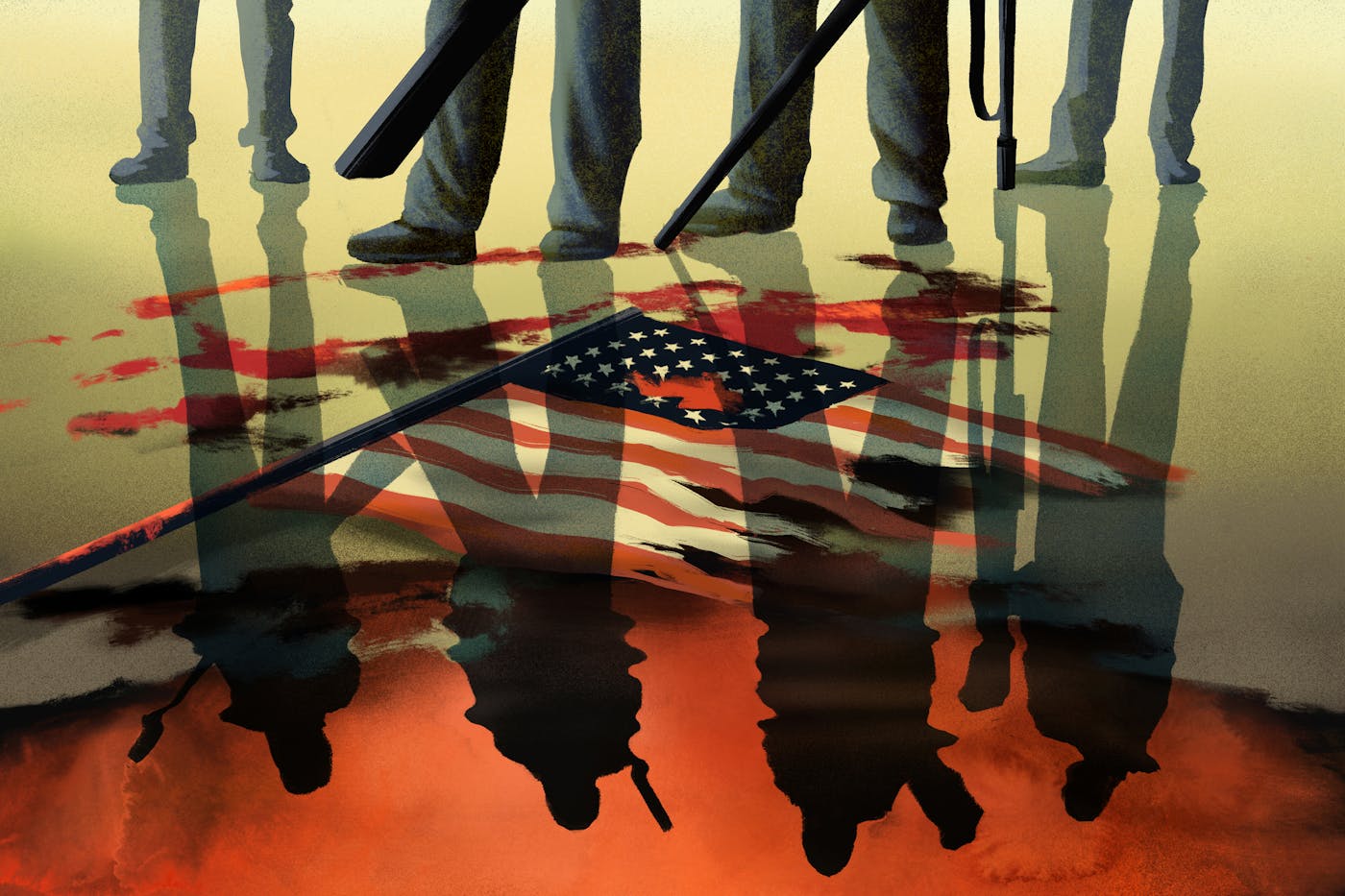Since January 20, 2021, when President Joe Biden was sworn in, there has in some respects been a creeping sense of normalcy to American politics, seemingly maintaining a status quo seen since the 1990s: a center-left Democrat in the White House and a Republican Party that has gone off the rails while out of power, whether it’s Newt Gingrich, the Tea Party, or today’s MAGA crowd. This is an illusion, however. The Republicans in power today have every intention of ending democracy via voter suppression, gerrymandering, and simply abusing their power to overturn election results they don’t like. Three grim scenarios for America’s future cannot be dismissed. The first two put us back in the post-Reconstruction era. The second is a threat we’ve never seen before: the functional end of our democracy for generations. The closest analogy is 1860, with the difference that the South had somehow managed to game the system into overturning the election of Lincoln and installed John Breckinridge as president.
Unless voters wake up—and Democrats wake them up—we’re on the verge of permanent, minoritarian, single-party rule, and few seem to realize what that would look like, much less the consequences. Once we reach that point, there’s a limited number of potential outcomes. This article explores how we might reach each of them, and what they would look like. Spoiler alert: None of them are good.
Scenario One:
The Descent Into Two Americas
In one of his last speeches, Martin Luther King Jr. bluntly stated the truth about the United States as it had been for hundreds of years. “There are literally two Americas. One America is beautiful for our situation….” But, he cautioned, “there is another America. This other America has a daily ugliness about it that constantly transforms the buoyancy of hope into the fatigue of despair.” Coming out of the civil rights movement, there had been hope that the United States was moving away from its slavery and Jim Crow past, where the South was given free rein by the courts and Northern politicians (including Franklin Roosevelt) to wallow in poverty, corruption, and racism.
The postbellum Pax Americana was maintained simply by everyone implicitly agreeing to ignore the ugly glaring truths about the South. Harry Truman, appalled by the treatment of Black service members returning home from World War II, issued an executive order to desegregate the U.S. military, thereby violating that unwritten truce. This event set in motion the series of events that led to the GOP being the party of the South that it is today.
Through the Goldwater presidential campaign to Nixon’s “Southern strategy” to Reagan’s reliance on the Moral Majority in the 1980s to the Gingrich revolution of the 1990s, the GOP has become the party of white Southerners’ grievance on every social issue where the rest of society has left them behind: abortion, same-sex marriage, sodomy laws, LGBTQ materials, and teaching an accurate history of race in the United States.
The Supreme Court decision in Dobbs v. Jackson has made it clear that only rights specifically enumerated in the Constitution will be upheld, such as religion and access to guns. All other rights are at the whim of whoever is running the state. Republicans have ensured through gerrymandering, voter suppression, nonproportional representation, and the ability to overturn elections that they will always be calling the shots. The results will be as predictable as the tides: We are on our way back to the Two Americas of the pre–civil rights era that King would be all too familiar with.
A cursory examination of Florida, Texas, and other conservative states gives a clear idea where this is going in the long run. The most obvious is the potential bans on abortion in roughly 26 states. Given that white evangelicals are most likely to favor laws with no exceptions for rape, incest, or life of the mother, and the lack of political competition in general elections, politicians in those states will pass ever more draconian anti-abortion laws. This includes fetal personhood bills and laws that allow for prosecuting women who get abortions and preventing women from leaving the state for the purposes of getting an abortion.
Similarly, the demise of Roe means the likely end someday of Griswold v. Connecticut (which overturned laws forbidding married people to obtain birth control) and Eisenstadt v. Baird (which extended Griswold to unmarried couples) as well. Conservative state officials are already lining up to pass laws that target certain types of birth control that they consider abortifacients, such as Plan B and IUDs. The result of these sorts of bills will be higher maternal mortality, more poverty, higher infant mortality, more child abuse, and more child neglect, as people who can’t afford children, shouldn’t have children, or don’t want children are forced to have them in states with absolutely no intention of providing a social safety net.
These same states will use the end of Roe to make life for LGBTQ people a living hell as well. It seems clear that the Supreme Court will overturn Obergefell v. Hodges (Chief Justice John Roberts, now the court’s “moderate,” dissented in that case), which will result in same-sex marriage quickly becoming illegal in 30-plus states again. The court will also likely eventually reverse Lawrence v. Texas, which overturned sodomy laws, and make consensual homosexual acts illegal again in 15 states. Florida’s “Don’t say gay” law is a successful attempt to keep LGBTQ students and teachers closeted. School boards and libraries around the country are being forced to remove books with LGBTQ material. Texas has used child protective services to try to take trans youth from supportive homes, while legislators in Virginia are attempting to ban the sale of books with LGBTQ themes to minors. Given the current demonization of LGBTQ people as “groomers” and “pedophiles,” there are fears that conservatives will look to take children out of the homes of LGBTQ parents.
Nor will racial and ethnic minorities fare any better. Schools in minority neighborhoods are already underfunded. So are health care systems. The private school system as we know it was largely a result of white evangelicals trying to dodge desegregation efforts after Brown v. Board of Education and other rulings. Southern states already have some of the highest levels of infant and maternal mortality. They also have among the lowest life expectancies, with Mississippi falling behind Honduras, Nicaragua, or Vietnam. Texas is seeking to overturn Plyler v. Doe (which requires states to provide education to residents). A Supreme Court that ceases to care about disparate impact or outcomes clears the way for these disparities to only get worse.
Corruption in the old South was rampant. After all, who else were you going to vote for? The Republican Party no longer had any political power, or hope of being elected, in the South after the end of Reconstruction. Similarly, Ohio’s legislature has been rocked with scandal after scandal, and the Texas attorney general has been under indictment for fraud for seven years, with no effect. Disney dared to cross Republican Governor Ron DeSantis and was quickly punished with revocation of its self-governing status. He also blocked money for the Tampa Bay Rays’ new training facility after the team tweeted against gun violence
By the end of the decade, the result may well be a country where minorities, women, LGBTQ people, and their families flee red states in a second great migration, further polarizing American demographics. Many corporations reliant on a skilled workforce will avoid opening new offices in red states, once again relegating them to a depressed service economy–oriented backwater. This is likely to set off a death spiral of further reduced government services, while scapegoating disfavored minorities as being responsible for the decline. Civil rights for the people who remain will deteriorate, as neither police, nor state courts, nor federal courts will be interested in upholding claims.
If all this sounds familiar, it should. This is effectively a reset to where the United States was before the civil rights movement, and where we were after the end of Reconstruction. The difference is that now Republicans almost certainly will not take a live-and-let-live attitude toward blue states. They have the upper hand and will do everything in their power to make blue states live under red state rules. Examples would include a national abortion ban and refusing to release federal funds to states that enforce civil rights protections for LGBTQ people.
Senator Mitch McConnell has already signaled that a national abortion ban is a possibility. Red states will attempt to prosecute people who seek abortions in other states, supportive parents of trans youth, or LGBTQ parents who are deemed to have exposed their children to “obscenity” simply by being LGBTQ. These attempts will set up a showdown at the Supreme Court that could resemble nothing so much as a second Dred Scott decision.
After the 2024 election, especially if the Democrat wins it but the Republicans steal it, the devolution into two Americas is a near certainty. Republicans have reshaped the Supreme Court in their own image and no longer care if their social goals are deeply unpopular, because they are governing purely for their base. The question is, will Republicans be successful in asserting national control? And if they are, what comes next? Will blue states like California simply ignore federal laws and Supreme Court rulings? Will they make this independence official? Alternately, will they quietly acquiesce and pretend that there is a way to recover from a descent into competitive authoritarianism if everyone just gets out and votes? The most terrifying question is what happens if some substantial portion of the left decides violence is the only path back to self-determination. When a population collectively realizes that peaceful change at the ballot box, or by petitioning their leaders, is no longer possible, and when there are competing ideologies and lots of guns available, history shows that the result is often years of political violence: not necessarily outright civil war, but assassinations, mass shootings, arson, bombings, and so on.
Scenario Two:
Separation or Divorce? What a Divided United States Might Look Like
If the United States was a couple, any sane therapist would tell them to get a divorce before even worse domestic violence broke out. The two sides fight over the same sorts of things couples do: the kids, religion, what’s on TV, who makes more money. Beneath it all are seemingly irreconcilable differences. The two sides hate each other, are incapable of communicating anymore, and find each other’s demands and vision for where the marriage goes completely unacceptable. Worse, the GOP’s open infatuation with competitive authoritarianism is like a man telling his wife he plans on chaining her up in the basement so he can go “full time” with his Hungarian mistress.
But, as messy and complicated as a divorce is, a country with almost 250 years of history together, 330 million people, a GDP of over $20 trillion, and the world’s second-largest nuclear arsenal is many orders of magnitude worse. After 2024, it is entirely possible that GOP officials will control all three branches of government in near perpetuity, as their think tanks (such as the Claremont Institute) have made it clear they intend to seize power for “a generation or two” to remake the country in their own image. This term, the Supreme Court will decide Moore v. Harper, a case in which some court observers worry that SCOTUS will narrowly endorse the so-called independent state legislature (ISL) theory, which posits that state legislatures should have virtually unfettered powers to set rules for federal elections, meaning that state legislatures could potentially overturn election results and have the imprimatur of the Supreme Court in doing so. That could rig democracy permanently. While deep red states would cheer this development on, our future will largely depend on how blue states, and deep blue urban centers, react to this democratic decline.
There are several possible triggers that may lead individual states to consider a separation or a divorce. One is that the United States first goes through the “two Americas” phase described above. As painful as that would be, it at least would represent an uneasy truce of a sort. This truce is unlikely to last, though, as the right will undoubtedly attempt to enforce its cultural, legal, and religious hegemony through the federal government. The rate-determining step in reaching a point where blue states find the situation intolerable rests with the courts, which the GOP will fill with partisans who will eventually find excuses to ignore the states’ rights they espoused as members of the Federalist Society.
Another possibility is that rather than a separation happening because of years of pressure building up, it will be a cataclysmic event that causes people in blue areas to come to the violent, widespread realization that they no longer live in a country where their vote can actually determine the outcome of elections. Maybe it is the GOP overturning a presidential election that a Democrat clearly won, as Republicans are already preparing to do. Maybe it is using a corrupted DOJ to indict a governor in a blue state that is thwarting them. Regardless of the triggering event, it is something that snaps the public out of complacency and alerts them to the reality that there is no possible way to vote their way back to a government they want.
As extreme as this sounds, the polling data show that a lot of Americans are already thinking about a breakup of the United States. Based on polling data from a 2021 YouGov survey that asked, “Would you support or oppose [your state] seceding from the United States to join a new [regional union]?” 66 percent of Southern Republicans said they wanted secession. Shockingly, 47 percent of West Coast and 39 percent of Northeast Democrats were ready to call it quits as well. These figures are even more supportive of secession than a similar poll conducted in February 2021. Desire for secession and formation of regional unions among all three groups has risen significantly in a relatively short period of time, though the survey noted that these answers “reflect initial reactions by respondents about an issue that they are very unlikely to have considered carefully.”
Given that there is mutual interest in a split, it raises the question of what it might look like. I tend to separate the possibilities into what I term “soft secession” and “hard secession.” These are roughly akin to separation and divorce, using the couples-therapy analogy.

There are several ways soft secession could manifest itself. It could be something like the British Commonwealth, where nations like New Zealand and Canada theoretically still owe allegiance to the crown, but they are their own separate countries, and the monarch’s role is entirely ceremonial. Another example might be the autonomous Kurdish region in northern Iraq. While formally part of Iraq, the government in Baghdad exercises little actual control, and the Kurds have their own armed forces, which work with the Iraqi army in operations against ISIS, for example.
Soft secession may be possible, because a large percentage of the GOP base would love to say “good riddance” to Democrats and their “San Francisco values.” They would relish the opportunity to force undesirables out of “their” country and to have complete freedom to create the monocultural Christian dystopia they have long dreamed about.
Hard secession is by far the more dangerous of the two possibilities. This would involve a clean break: no more ostensible allegiance to a government in Washington, simply regions breaking off and forming their own countries based on common culture, religion, ethnicity, and regional identity. The closest modern examples of this scenario highlight why it is so fraught with danger. When the Soviet Union broke apart in 1991, it devastated the economy, life expectancy took a significant hit, nuclear materials were left scattered about successor states, and kleptocratic oligarchs ran amok. When Yugoslavia broke apart in the early ’90s, it resulted in a decade of civil war and genocide. Or we could be looking at an armed standoff, as with Taiwan and China.
This is a real risk. Separation, even if mutually agreed upon, is a legal and bureaucratic nightmare. Even worse would be drawing the boundaries of new nations. The political map of the United States consists of vast stretches of mostly empty rural red areas, and tiny deep blue patches of densely populated urban areas. It is unlikely that these deep red areas would accept being part of a new, Democrat-dominated “Cascadia.” Conversely, any talks of secession draw immediate and quite understandable cries from people in deep blue urban areas of the South, such as Austin and Atlanta, not to mention smaller college towns like Chapel Hill and Gainesville. They have zero desire to live in the Republic of Gilead, and do not feel that they could flee. Those unable to flee will find themselves back in a new Jim Crow state: effectively disenfranchised, second-class citizens by both law and culture. The conclusion of many people who study civil war is that any attempt to redraw the nation’s boundaries would have a high probability of violence and bloodshed. Stephen Marche has written about this in books and articles, and he concludes that, while secession might be the lesser of two evils, it’s nearly impossible to accomplish without ending up in a bloody internecine conflict.
Given how brutally difficult and contentious any national separation or divorce would be, it forces the question of what happens if the United States decides to call it quits? Or, if violence does break out, what would it look like?
Scenario Three:
The Second Civil War
The American left has not always been devoted to the notion that violence is never the answer. In fact, one of the greatest heroes of the North during the Civil War was (depending on your perspective) either a terrorist, an insurgent, a freedom fighter, a madman, a martyr, or the paragon of a righteous cause.
In 1856, after pro-slavery forces sacked the free town of Lawrence, Kansas, and anti-slavery Senator Charles Sumner was nearly beaten to death on the Senate floor by Representative Preston Brooks of South Carolina, abolitionist John Brown had had enough. Slavery was to him an intolerable evil, and pro-slavery forces were the aggressor. He knew, even then, that there was no hope of a political end to the Slave Power. Only violence would bring it down. He traveled to Kansas with his sons and other radical abolitionists to take matters into their own hands, resulting in the Pottawatomie massacre of slave hunters and pro-slavery settlers. This poured kerosene on the simmering “Bleeding Kansas” insurgency, in which 55 people were killed between 1855 and 1859.
In 1859, after the raid on Harpers Ferry, John Brown became the first American executed for treason. Yet only two years later, Union soldiers marched to battle singing “John Brown’s Body,” whose tune and lyrics eventually became the “Battle Hymn of the Republic.”
Today, the United States is every bit as divided as it was in the 1850s. Peter Turchin, a historical social scientist whose predictions have been uncannily accurate (he predicted in 2010 that political friction would come to a head and result in violence in 2020), has spent the last two decades building quantitative mathematical models to predict social and political instability. In 2017, experts speaking to Foreign Policy estimated that the odds of civil war were anywhere between 5 to 95 percent, with an average of 35. Today, models are telling us that extreme political unrest will likely get much worse. “We are almost guaranteed” five hellish years, Turchin predicted in The Atlantic, and he foresees it being a decade or more because there is no longer a peaceful political path within our governmental structure to relieve the pressures it is subjected to.
The political pieces are already there. Just as in 1850 or 1920, we have a country with a weak federal government where blue states are tolerable places to live, and red states are corrupt, single-party human rights abominations. Ultimately, under prolonged Republican control of the White House and the courts, this will destabilize and almost certainly produce a second Dred Scott–like decision that reverses decades of progress in civil and individual rights and sets dark events in motion. Alternately, the entire country could end up under an authoritarian regime, like Hungary or Russia; or blue states could attempt soft or hard secession, with the GOP-controlled government determined to bring rogue states back in line.
Regardless, the United States is heading toward conditions that a large percentage of the country, if not the majority, will find intolerable. Like John Brown, many people will ascertain that, since the United States is no longer a functioning democracy, there is no nonviolent path to restore their civil rights or remove the incumbent party from power at the state or federal level. It becomes a matter of when, not if, acts of left-wing political violence begin to occur, which could well set off rounds of escalating tit-for-tat bloodshed.
If it happens, the next American civil war won’t look like the first: There won’t be troops marching into battle, uniforms, or standing armies. It will be an insurgency, and the American right has already left a 30-year–long road map for what it will look like. Over the past decade, political extremists have killed nearly 450 people in the United States. Seventy-five percent of those crimes were committed by right-wing extremists, according to a 2021 analysis by the Anti-Defamation League, while only 4 percent were committed by the left. (For comparison, Islamists committed 20 percent.)
Right-wing terrorists have targeted Democratic politicians, and even Republicans. The January 6 insurrection was intended to prevent Vice President Mike Pence from presiding over the vote to certify the election results, with lethal force if necessary. There was also the plot to kidnap and kill Democratic Michigan Governor Gretchen Whitmer. More recently, a militia member killed a retired judge in Wisconsin, and had a hit list that included Democratic Governor Tony Evers.
Stochastic violence (public demonization of a person or group resulting in the incitement of one or more violent acts, which is statistically probable but whose specifics cannot be predicted) is a key feature of modern American terrorism because it is so difficult to detect, deter, and prevent. Abortion clinics, historically Black churches, and centers that support the LGBTQ community have long been the targets of arson attacks that rarely produce arrests or convictions. After months of Fox News host Bill O’Reilly’s harassment campaign against abortion provider George Tiller, he was assassinated in his own church. Today, right-wing provocateurs like the Libs of TikTok social media accounts run by Chaya Raichik agitate against drag queens and doctors who treat trans youth, who then receive death threats. Recently, Boston Children’s Hospital received bomb threats after being singled out on social media by Raichik and others.
As American troops in Iraq learned, it is also difficult to stop terrorists who have no intention of surviving the attack. Such is also the case with right-wing mass shooters in the United States who have targeted Black churches or supermarkets and synagogues. Preventing these attacks is nearly impossible, because you have no idea who will do it, when, or where. The only thing we know is “how”: Obtaining military-style firearms is both easy and treated as a constitutionally guaranteed right. Thus, stochastic terrorism benefits from the old military adage that “he who defends everything, defends nothing.”
Molotov cocktails and assault rifles are both easily obtained and nearly unregulated in the United States; the reason that we haven’t seen nearly as much left-wing violence is more a lack of desire to resort to violence than a lack of opportunity. There are signs that may be changing, however. A pregnancy crisis center (which exists to prevent women from getting abortions and rarely provides prenatal care) in Illinois was firebombed. Another in Wisconsin was burned, with a group calling itself “Jane’s Revenge” claiming credit. The group threatened to repeat similar attacks around the country.
Polling also indicates that pressure is building. A recent poll commissioned by the Southern Poverty Law Center found that 44 percent of Democratic men under the age of 50 support “assassinating a politician who is harming the country or our democracy,” compared with only 34 percent of their Republican counterparts. Forty-two percent of Democratic men under the age of 50 also supported “participating in a political revolution even if it is violent in its ends,” compared to 46 percent of similarly aged Republican men. These are the demographics that matter, because younger men are the ones who are historically most likely to actively participate in an insurgency.
Military analysts studying irregular warfare refer to the “fire triangle” model of insurgency, which requires fuel, oxygen, and an ignition source. In the United States, the fuel is two populations of well-armed people who hate each other and will never accept the other side’s demands. The oxygen is an environment intolerable to one or more sides, with no possible political solution. The spark is going to be something resembling John Brown’s Pottawatomie massacre. If and when the GOP takes permanent control of the federal government, it would only be a matter of time. With millions of angry, radicalized, hopeless young men and easy access to firearms, the statistical probability of a triggering event to provide the spark is essentially 100 percent.
What happens afterward is likely to be a mix of Bleeding Kansas, the Years of Lead in Italy (years of neofascist terror peaking in the 1970s), and The Troubles in Northern Ireland, with assault rifles and Molotov cocktails instead of bombs serving as the weapons of choice for both sides. The violence would likely evolve into a series of stochastic but escalating tit-for-tat kidnappings, assassinations, mass shootings, and firebombings. Rather than attempting to remove the fuel source (by taking away weapons) or the oxygen (by compromising and restoring democracy and civil rights), the GOP-led government would crack down, while local police forces would give free rein to right-wing militias to target anyone they think might be sympathetic to insurgents (particularly anyone visibly LGBTQ). As anyone who has done counterinsurgency work knows, this is just going to pour more gasoline on the fire.
Sure, we could avoid all this if the United States had a proportional representation system of government. Or if we passed laws to uphold voting rights and end gerrymandering. Or if the Senate wasn’t skewed by 6 to 7 points toward the GOP. Or if Republicans (and their base) weren’t dedicated to achieving power and enforcing their vision for a Christian nationalist single-party state on the rest of the country by any means necessary. Or if the judiciary hadn’t been filled with partisan hacks.
And if a frog had wings, he wouldn’t bump his butt when he hopped. Which is to say that the things that might prevent these nightmare scenarios from coming to pass are functionally impossible.
We are entering uncharted territory as a nation: There has never been potential for so much internal carnage during a civil war or insurgency. There are roughly 400 million firearms in the United States, and 20 million of them are assault rifles. To put this number in perspective, that is enough to give all 700,000 members of the Ukrainian army, Territorial Defense Forces, and reserves, along with every Russian combatant, 24 modern assault rifles. Each. The United States produced only 5.5 million M1 Garand rifles and 6.1 million M1 carbines to equip U.S. forces during World War II and the Korean War. The AR-15 can kill far more people far more quickly and at a greater range than either of these, due to its magazine size and muzzle velocity. The amount of weaponry available to a country that may be on the verge of civil war is unfathomable.
Once democracy in the United States fails, as it almost surely will within the next few years, it guarantees that eventually many people will reach the same conclusions John Brown did in 1856. It just becomes a matter of when, not if, someone strikes the match that lights an uncontrollable fire.






